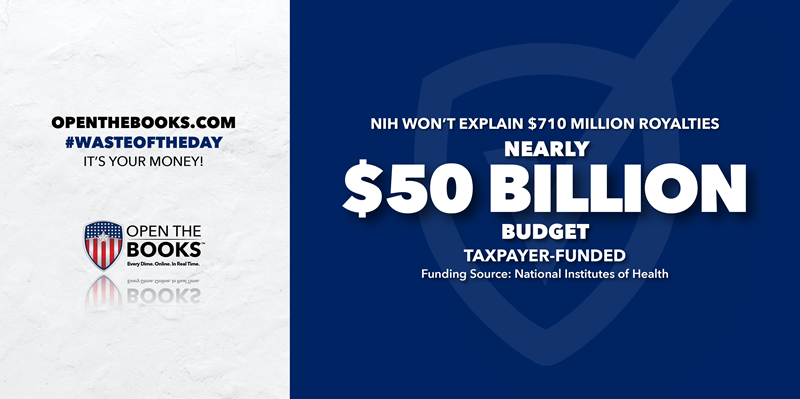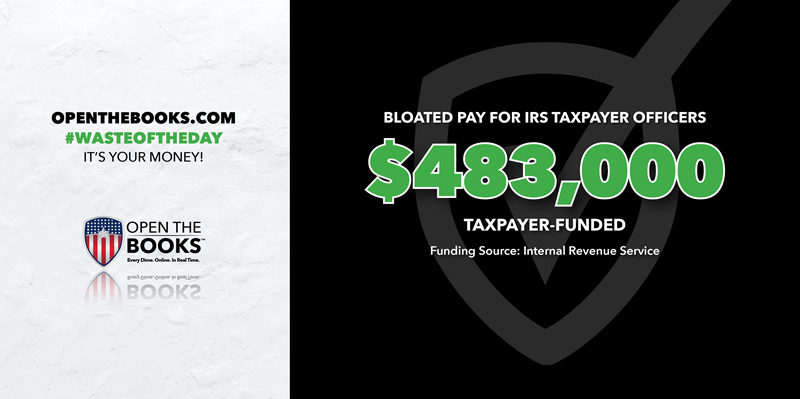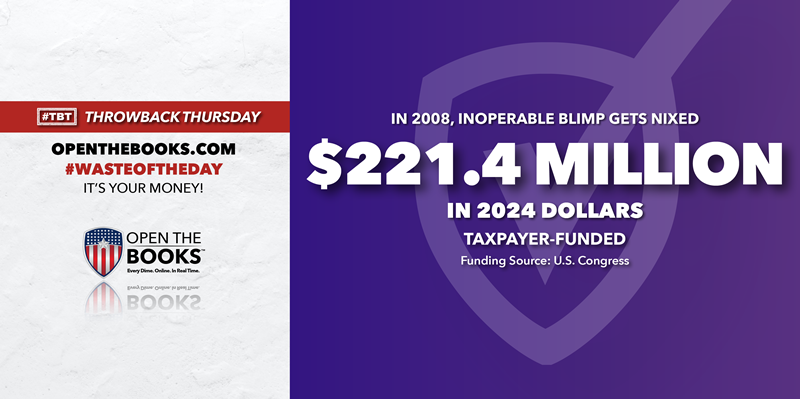
NIH Still Hiding Details of $710 Million In Pandemic Royalties
July 1, 2024

Topline: Pharmaceutical and healthcare companies paid a total of $710 million in third-party royalties to the National Institutes of Health in 2022 and 2023, according to records obtained through federal litigation by OpenTheBooks.
Out of the $710 million, there was $690 million paid to one part of the NIH, The National Institute of Allergies and Infectious Diseases (NIAID), formerly run by Dr. Anthony Fauci. There were 260 of its scientists who received a payment; however, the dollar figure paid to individual scientists is still hidden and redacted in the disclosures.
Third-party royalties are payments made by private companies who use technologies previously invented by scientists working for the government. NIH leadership has admitted that each payment has the appearance of a conflict of interest, yet they asked the American people to trust them, because “we have firewalls.”
Taxpayers are very generous with NIH. Last year, Congress appropriated a $50 billion budget for NIH. Yet, the agency resists basic transparency of its key operations and programs.
Key facts: Moderna made 29 of the payments, and Pfizer made nine. However, the federal government paid $10 billion and $60 million to the vaccine makers, respectively, who, in turn, made payments in the form of third-party royalties that enriched the NIAID and its scientists. Moderna alone paid $400 million in third-party royalties to NIAID (we know this from court records, not from NIH disclosures).
There were 139 royalty payments from Changchun BCHT and China National Biotech Group, two vaccine developers owned by the Chinese government.
Another 66 payments came from Medigen Vaccine Biologics Corp, the Taiwanese company that created the MVC Covid-19 vaccine.
Dean Metcalfe, chief of the NIAID’s Mast Cell Biology Section, received 79 royalty payments. Four other scientists each cashed more than 40 checks. However, the NIH still refuses to reveal the names of scientists receiving 5,000 payments since 2009, claiming the names are “trade secrets.”
The third-party royalty cash haul during the pandemic represents a sharp increase from the $325 million royalty payments the NIH received from 2009-2021.
OpenTheBooks twice sued NIH in federal court with the assistance of the nonprofit, public interest law firm, Judicial Watch because the agency refused to comply with the Freedom of Information Act requests.
After years of federal litigation, NIH still won’t reveal the value of each individual payment, just the overall dollar total to NIH and its individual institutes, like NIAID.
Background: Rep. Nicole Malliotakis (R-NY) asked Dr. Fauci about OpenTheBooks’ findings in a House hearing on June 3, but Fauci dodged the question by denying that he personally accepted any Covid-19 related royalty payments. “Somebody did, but not me,” Fauci said.
Fauci and his wife, Dr. Christine Grady, the chief bioethicist at Fauci’s previous employer, NIH, collectively earned nearly $1 million in cash compensation and estimated benefits paid for by taxpayers in 2022, OpenTheBooks previously reported.
Search all federal, state and local government salaries and vendor spending with the AI search bot, Benjamin, at OpenTheBooks.com.
Summary: OpenTheBooks will continue to fight in federal court until we open the books on the third-party royalty program at NIH.
The entire complex of third-party royalties continues to be cloaked in too much secrecy.
For example, since October 2009, on nearly 5,000 transactions, the name of the scientist continues to be redacted; all 70,000 royalty transactions have the amount of the individual payment redacted; and NIH hasn't updated their license database since 2020 – so we can't match inventions to the scientist or entity licensing the invention, i.e. all the Covid-era licensing.
Tennessee Voters Pay for Congressman’s Mail
July 2, 2024

Topline: It’s a bit difficult to run for reelection with only $95,000 in campaign cash on hand, but Rep. Andy Ogles (R-TN) found a way around that issue.
He billed taxpayers $335,000 last year to mail out “constituent communications” showcasing his own accomplishments, according to The Tennessean.
Key facts: Ogles published 63 different mailers and digital ads approved by an oversight committee since January 2023, The Tennessean reported.
The mail expense included in Congressional office budgets is technically supposed to be for spreading important information about town halls or new laws, but it’s often used by members of both parties to send pseudo campaign ads.
Two other Republican representatives from Tennessee, Diana Harshbarger and David Kustoff, also spent more than $200,000 on their communications.
The letters cannot directly reference elections or attack political rivals.
Also in May, Ogles admitted to mistakes that misled the Federal Election Commission about how much money his campaign had available. Ogles filed paperwork in April 2022 stating that he had loaned $320,000 of his own money to the campaign, but he now says he only loaned $20,000 and pledged to donate more if necessary.
Search all federal, state and local government salaries and vendor spending with the AI search bot, Benjamin, at OpenTheBooks.com.
Background: Ogles and other Congress members can send communications through the “franking” privilege that gives a campaign advantage to incumbents and leaves constituents with the bill.
The Senate caps franked mail spending at $50,000, but in the House it’s unlimited.
The privilege can’t be used 90 days before an election, but prior to that, any form of communication is fair game: physical mail, internet ads, radio broadcasts and more.
Supporting quote: "Many people in middle Tennessee still don’t know who their Congressman is,” Ogles said in a statement to The Tennessean. “It is important that constituents know who their representative is, how my staff and I can assist with their needs, and the ways in which I’m effecting change on their behalf in D.C.”
Summary: Most constituents have access to Google as well as snail mail. Ogles’ campaign ads might lose their effect once voters realize they’re the ones paying for them.
Waste of the Day: IRS “Taxpayer Experience Officer” Profits Off Taxpayers
July 3, 2024

Topline: The IRS has appointed a new “taxpayer experience officer,” whose salary is paid by – who else – taxpayers themselves.
The agency hasn’t publicly announced Fumi Tamaki’s salary, but her predecessor earned nearly $200,000 in 2022, according to payroll records obtained by OpenTheBooks through an open records request.
Key facts: Current Deputy Chief Taxpayer Experience Officer Courtney Kay-Decker earned $187,000 in 2022. Adding in estimated benefits of 25%, that means the soon-to-be-two-person office costs taxpayers over $483,000 each year.
Takami and Kay-Decker will “pave the way for continuous improvements for … the tax community,” according to IRS Commissioner Danny Werfel – whose position earned $168,000 in the latest available payroll data.
The IRS paid out six-figure salaries to 11,846 people in 2022, with some employees earning up to $261,400.
That resulted in a total payroll of $4.9 billion.
Search all federal, state and local government salaries and vendor spending with the AI search bot, Benjamin, at OpenTheBooks.com.
Background: The Taxpayer Experience Office is tasked with helping manage the $80 billion in supplemental funding the IRS received from the Inflation Reduction Act in 2022. Republicans fought back and reduced that funding to $58.4 billion this March.
The office also works closely with National Taxpayer Advocate Erin Collins, who the IRS has dubbed the “Voice of the Taxpayer.” She makes over $203,000.
Collins and the taxpayer experience office are good at identifying issues at the IRS, such as in a recent report to Congress announcing that it takes an average of 22 months for the agency to refund victims of identity theft. It remains to be seen whether they can fix those issues.
Summary: The best way to improve the taxpayer experience would be to slash the IRS’ bloated payroll and save Americans some money.
Throwback Thursday: Pentagon Cancels $150 Million Blimp Program
July 4, 2024

Throwback Thursday!
Topline: In 2008, Congress went against the Pentagon’s wishes and forced it to buy a surveillance blimp the military didn’t even want.
The project ended up costing at least $151.7 million, or $221.4 million in 2024 dollars, and was canceled in 2011 because the blimp couldn’t even fly.
That’s according to the “Wastebook” reporting published by the late U.S. Senator Dr. Tom Coburn. For years, these reports shined a white-hot spotlight on federal frauds and taxpayer abuses.
Coburn, the legendary U.S. Senator from Oklahoma, earned the nickname "Dr. No" by stopping thousands of pork-barrel projects using the Senate rules. Projects that he couldn't stop, Coburn included in his oversight reports.
Coburn's Wastebook 2008 included 65 examples of outrageous spending worth more than $1.3 billion, including the money for the Pentagon’s blimp.
Key facts: The High Altitude Airship was designed to be 25 times larger than the Goodyear blimp and fly 12 miles above the ground on spy missions. The Missile Defense Agency gave Lockeed Martin $149.2 million in 2006 to build 10 airships.
Attitudes quickly changed once officials realized the blimps would take too long to build and have limited functionality, and the Pentagon tried to scrap the project even though the money had been spent.
Lockeed Martin still wanted more cash. The company turned to Sen. Sherrod Brown and Rep. Tim Ryan, two Democrats representing Ohio at the time, and convinced them to earmark $2.5 million for a blimp facility in their state.
The blimp was on its way to being built over the Pentagon’s objections – if it could actually fly. The project was defunded when a test flight failed in 2009 and folded into the similar HALE-D program, which failed its own test flight in 2011.
Background: The High Altitude Airship is not a unique example of forced spending. Every year, Congress requires the Pentagon to sustain projects not in its budget request, taking funding from things the military actually needs.
In 2023, Congress removed $17.2 billion from the DOD’s budget request and replaced it with an estimated $61 billion of lawmakers’ own pet projects, according to budget documents reviewed by OpenTheBooks.
Lockeed Martin surely has no complaints about U.S. defense spending. OpenTheBooks found that the company received over $257 billion between 2019 and 2023 – 7% of the Pentagon’s entire budget.
Search all federal, state and local government salaries and vendor spending with the AI search bot, Benjamin, at OpenTheBooks.com.
Summary: $150 million gone. No blimps, nor any desire to even use the blimps. That’s as bad as it gets.
Biden Hasn’t Mentioned Full Cost of Micron Grant
July 5, 2024

Topline: President Joe Biden and Sen. Chuck Schumer (D-NY) have proudly been touting the $6.1 billion grant the U.S. will provide for Micron Technologies to build computer chip factories in New York and Idaho. That’s the dollar figure in the White House’s press release and in the Associated Press article about the investment.
But a new analysis from Syracuse.com found the factories will actually cost taxpayers over $20 billion in subsidies and tax credits from federal, state and local governments.
Key facts: The grant comes from Biden’s 2022 CHIPS and Science Act, which directed $52.7 billion of its $280 billion price tag toward semiconductor manufacturing.
The same law gives chip manufacturers a 25% tax credit on their expenses for buildings and machine to make semiconductors.
Micron will spend $100 billion over two decades on its factory complex in Clay, N.Y., which will create 49,000 jobs, according to the AP. Another facility in Boise, Idaho will cost $15 billion and create 17,000 jobs. For every dollar that Micron spends on chip-making, 25 cents will come out of taxpayers’ wallets.
Micron will also receive $2 to $3 billion in job creation tax credits from New York and save billions more on sales taxes, according to Syracuse.com.
New York also plans to match Micron’s $250 million investment in “workforce development and community priorities.” Supporters point to a state study that shows the factories will bring a $17 billion boost to the New York economy.
In Idaho, the company will benefit from reduced state taxes.
Micron will also receive a $7.5 billion low-interest loan from Washington.
The final tax credits will be listed on Micron’s private tax returns, so the public may never know the exact dollar cost of all the incentives.
Search all federal, state and local government salaries and vendor spending with the AI search bot, Benjamin, at OpenTheBooks.com.
Background: The largest CHIPS Act grant so far gave Intel $8.5 billion to open factories in Arizona, New Mexico, Ohio and Oregon.
The program is meant to incentivize technology companies to hire American workers instead of moving their production overseas.
But when at least some of the CHIPS Act investments inevitably fail, it will be easy for CEOs and politicians to argue that the damage can be undone with more time and more cash. After all, it’s not their money that’s on the line; it’s taxpayers’.
Summary: Why should a private company get billions in public subsidies and tax credits? At the very least, politicians should be honest about the true dollar figure.
The #WasteOfTheDay is presented by the forensic auditors at OpenTheBooks.com.